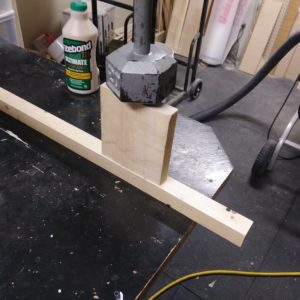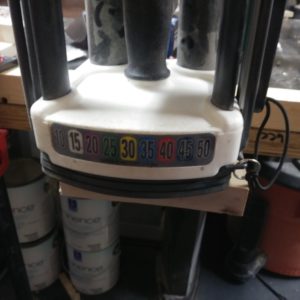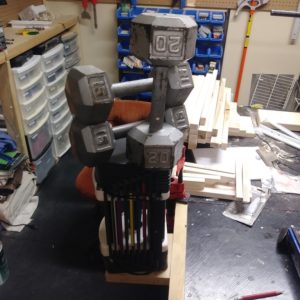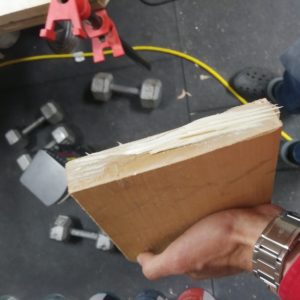I was reading https://www.finewoodworking.com/2006/03/01/building-bookshelves-to-last and I saw a mention of how gluing end grain supposedly doesn’t work. Specifically, it says: “Because a dado joint produces mostly end-grain surfaces, adding glue increases the strength only nominally.”
This is something I see every now and then from seemingly authoritative sources, but the statement never comes with an explanation.
Can someone please explain why in practice it’s supposed to not work? I ran an experiment that convinced me that it does work:
I glued the end-grain of a piece of maple to the face of a piece of SPF with Titebond 3. I found that it took about double the amount of glue I would normally put on a face-to-face joint.
After it dried I did the test. Not very scientific but I just needed to get an idea. The SPF was clamped to the bench with pipe clamps so that all the glued-on maple was unsupported, and I started easy (the numbers on the weights are pounds I believe).
I added more, and more, and more, and more, and more weights on top.
The last extra 20 pounds (on top of the pile in the last photo) broke it.
Notice that on at least 50% of the surface the glue held, but the wood broke off.
Does anyone have similar or opposite experience? What wood and glue did you use?



















Replies
It is because end grain draws the glue away from the surface by capillary action.
Somewhat dependent on wood species, but generally true for any to one degree or another. Coarse grain wood like red oak one of the worst.
Epoxies, polyurethane glues not as susceptible.
One way to deal with the issue is to "size" the endgrain by precoating, waiting a few minutes, and apply a fresh coat just before glueing.
I'll add that your strength test only shows one kind of strength (tensile?). I would imagine that if you tried a different test, where instead of resting the weights you dropped them on the maple, that it would not fare so well. That's impact strength.
In any event, your joint is only end grain on one piece, so that's not the worst case. End to end is nearly impossible to make work. There are legit occasions to glue end grain, but in the main, you want to reinforce in way: tenons, splines, etc.
But has someone actually done a true comparison? I wonder if this is just an urban legend.
In my experiment the wood broke before the glue. It was softwood sure, but even so: the expetriment results suggest that the stated problem may be severely exaggerated.
I ran what I would consider a pretty comprehensive test of the glue on end grain myth. While I do agree the technique has to change a bit when dealing with end grain it still in my opinion has value.
I had a bunch of 3" wide short pieces of Maple, Red Oak, Cherry, Ash, and Pine laying about. Roughly 12" long each. I made a SQUARE and CLEAN cut along one of the edges of each piece. I then applied glue to the end grain of both pieces that would be fitted end to end. I did same species, mixed species, etc. I applied liberal amounts on each end grain of Titebond I, II, and III to the boards. (one type of glue per joint) Clamped them all up and let them sit just about 20 hours in the clamps. to my delight all but one stayed straight. I then clamped one of the pieces to the bench with the glue joint about 1" over hanging. I put a C clamp on the end of the other piece, and attached a hook to the c clamp and started hanging weights, until failure. They all exceeded 200 lbs before it cracked. Red Oak to Red Oak the wood failed next to the glue joint at 250 pounds Not exactly sure since they fell to the floor and I was getting my toes out of the way.
so My conclusion is end grain does provide strength with a good joint to start with.
Probably repeating what's already been said, but here's my two bits.
1. Apply a layer of glue to the end grain and let it dry. It gets absorbed but leaves a thin film on the surface.
2. Once the end grain glue is dry, add an application to this film. It will not be sucked into the wood and will help add strength to your glue up.
Peace,
j
RWolinski: that's awesome, thanks for sharing.
People should really stop repeating that gluing end-grain doesn't work in principle. :)
Yup :-)
I think we can all mention some 'truism' that we have been taught in woodworking as well as other parts of our lives. Finish over waxed shellac, sun-tanning cherry, etc., etc.
I welcome the myth-busters as we can all use a re-adjustment now and then ;-) Advances in adhesives, tooling and metallurgy cause 'word of mouth wisdom' to expire every so often.
Wasn't there an episode of Star Trek where Scotty ended up working with Geordie and had al sorts of trouble because the "dangerous" limits had been reliably exceeded long ago?
If I find myself needing reliable strength from end grain and glue I pre-glue the end grain, let is soak in a bit and then re-apply and move along. Your success will vary with the type of stresses applied.
These sorts of tests have been done a lot, in most magazines. Search FWW for joint strength test for a start.
The weakest joint is always end grain to end grain. The glue holds, sure. But I wouldn't build anything using such a joint.
End grain to long grain, as you tested, is a little stronger. And then various other methods came in at different strength levels. Bits suits, pocket screws, dominos, lap, half lap, mortise and ten On. All sorts of joints have been tested, by lots of different people.
It's not like gluing end grain is useless. But I can't tell you a single situation where I would use it. It just isn't that strong.
Here’s a test- build a table and endgrain glue the aprons to the legs.
Or make some drawers the same way.
Let us know how that works out so we can skip all that work making mortises and tenons and dovetails LOL.
rwe2156 has the right answer. I was a furniture conservator for a number of years. The question is really does it hold up long-term? Expansion and contraction of the wood with seasonal changes and mechanical stresses from use will potentially loosen any glue joint.
http://johnbarfielddesign.com/
But that's not a problem with gluing endgrain, that's a wood movement problem. It would not apply (for example) in a dado which I'm sure everyone glues, even though it's a 100% end-grain-to-face-grain joint.
I agree with everything you all said. I would build anything just gluing end grain. What I usually take issue with are the statements many make on line and in articles when they are gluing up a box joint, or a dovetail and the say “...don’t put any glue on the end grain it adds no help....”. I think it does! My test wasn’t scientific at all it was just to show there is benefit in gluing there too.
So I'm confused about the post as your last picture seems to match with the quote you disagree with: "...adding glue only increases the strength nominally." When you glue face grain to face grain and try to break the joint the board will almost always break away from the joint as the glued portion is stronger than the wood fibers (assuming a good joint). Being generous and saying half of the wood is still attached to the joint in your picture and I would say it was a "nominal joint."
To be clear, not saying it doesn't add ANY strength (just like the quote), but the time and energy put into adding the glue and cleaning it up is not worth it. If you want to add glue there then do it, but you don't have to.
Not to mention today's adhesives are almost otherworldly when compared to glues of when I first started. And much overlooked I think is that a dado provides a shoulder which increases the strength of the joint overall.
A better experiment would be to build one bookshelf. Have one, four foot long shelf glued to the sides by their ends...the other inserted into dados along with glue.
I guarantee you that over time the shelf in the dado will exceed that of the other.
Look, end grain to end grain glue joints are very weak. End grain to long grain joints are a little stronger. End grain to long grain plus some sort of interlocking joinery (like a dado, rabbet etc) is stronger still.
What always drives me nuts is authors saying "don't bother gluing end grain" because it isn't that strong. Well, end grain to long grain plus interlocking joinery is a sound and stable way to build things. Adding glue to end grain can only increase the strength.
If we look at the big picture, and how the joinery relates to the whole piece, I think we'll be fine.
I agree with you PintoDeluxe. However, I think a lot of people don't find it's worth the trade off of having more squeeze out to clean up. For me, I glue it all!
I think AndrewSmithCanada makes a good point. End grain glue joints have strength. They are not the strongest joint, but they are not worthless. In engineering, you select the construction method to fit the need. You would not use this joint to attach a shelf to a case or for a drawer, that would not work, but end grain glue joints without any reinforcement are appropriate for low stress applications. People who disregard this joint are basically not using the full array of techniques available to woodworkers. I have built face frames for drawer cabinets with end to side grain glue joints and they have held for decades without issue. I realize they may not last 300 years, but I'm okay with that.
Thank you for the info listed here.
I have always added glue onto the end grain because I figured it couldn't hurt. From what I'm seeing here, there is data to back up that it does indeed add some strength to the joint.
I'm not trying to be rude, but all this talk and only two posts point to experiments that describe specific experience rather than theory.
To me if the wood breaks before the glue joint - that shows that the glue is working as well as I could hope.
If a glue joint breaks at 200 pounds of lateral force - that tells me it will support much more than of my builds will ever be subject to.
I also haven't mentioned a box I built years ago where the top is glued to the end-grain edge of the sides, and I regularly sit in the middle of that 1-meter-long box. It shows no signs of planning to break.
Has someone had the opposite experience where the problem was caused specifically by gluing end grain and not another error in the design?
"These sorts of tests have been done a lot, in most magazines. Search FWW for joint strength test for a start."
This? https://www.finewoodworking.com/2009/02/25/joint-strength-test
That says it was subject to a load of 473lb before it broke. I don't think my entire family combined weighs that much :)
That 1-meter box (if I have the right picture in my head) relies on the overlap for supporting you and your family, and the top and sides move in the same direction seasonally, yes? If so, the glue joint is not being stressed much by your sitting on it. If the top of the box is glued between the upright sides I'm impressed.
Everyone. I must say I’ve really enjoyed all the comments you’ve posted. This subject has been debated for decades. And we probably won’t be the last group of woodworkers to do so.
One last comment from me here. We all have made mitered corners on something and usually reinforce them because of the strength issue of the primarily end grain joint. I do now but before I became “wise” to the weakness of the end grain I didn’t enhance the corner with anything. I just made sure it was a clean flat joint. Went to a friends home last night and she brought out the tea box she uses almost daily that I made her in 1983 with just glued mitered corners. Still looks great. It is Cherry and the sides are about 5/8 thick. Would I make it that way today. Probably not but just wanted to conclude that adding glue to end grain can hold up or add to an already good job.
i think youre all looking at this the wrong way, yes end to end grain works in such situations like skirting boards or using pocket-hole screws or adding a spline or domino into a joint, but joints where a thicker lump of wood than 20mm/3/4" is used, the long term strength of end to end is still unbelievably poor. for instance, im racking my brain trying to think of a way to connect the leg of a table after it has been sawn off at 90 degrees (was NOT me, dont even get me started) but the simple truth about it is, even strengthening it half-way down with metal bar, the racking forces a table leg goes through wouldnt hold.
unless anyone has any other options, my only two would be to remake the leg entirely or replace with another metal option.
Hog off material on 2 sides of the leg and glue in long grain patches running several inches to either side of the cut. Once those are flushed up do the same on the other 2 sides. (assuming a square-ish profile) Best would be to make a new leg.
There are also plenty of YouTube videos duplicating your end grain results. I add glue to the end grain surfaces during a glue up.
I think if you want "science" and "theory", you should contact Gene Wengert and cut through all this. If you want affirmation then stay here.
https://www.woodweb.com/cgi-bin/forums/_email.pl?action=email_form&fm=Contact%20WOODWEB%20Page&poster=Gene%20Wengert&ad=tregnew_@23897@[email protected]
How do you all feel about dowels? I've seen lots of antique furniture literally come apart with a mallet.
Thinking about that, isn't it mostly end grain, too?
Or are we talking about the hole getting larger due to shrinkage?
And wouldn't the same principle apply to a dado --> that movement is the main culprit, not necessarily joint strength?
The problem with dadoes is they don't hold a carcase together without some other fixing. When I build a dresser I do dovetailed dividers, with book shelf one middle shelf fixed.
There's a difference between "strong" and "strong enough"- that is, how much strength you actually need for the load that'll be applied. If that table leg would never be stressed laterally (unlikely) it might be strong enough. But it will get racked, pushed bumped, leaned on, etc., for which it wouldn't be strong enough with just end grain glue. Parts that dont get that stress might work. IMO.
Dowels, I thought relied on the strength of the dowels themselves, with the glue just holding them inlace.
Dowels are a magic mix of end / cross / long grain depending on where they land. If reinforcing a butt joint like rail-to-stile one part has lots of long grain glue surface and the other has a mix of end grain to long grain and long-to-long crossgrain. For tabletop glueups the alignment matters more that any strength added.
As I understand it, dowel joints destroy themselves through wood movement. The round dowel is actually a wooden board that will move more in one direction than the other, effectively changing from round to oval with the seasons. this alternates between enlarging the hole in one plane and then pulling away from it. The dowels become loose for the same reason that wood screws need to be tightened seasonally, a sort of compression cycle that distorts the hole. Most dowels are a different species from the boards they are set in which enhances the effect.
It seems to be a myth, most likely perpetuated by the fact that with end-grain it is the glue that fails and not the wood. However, watch this video which does a comparison between the various joints, side-to-side, side-to-end, end-to-end, and the wood itself.
https://www.youtube.com/watch?v=m7HxBa9WVis
Thank you Patrick Sullivan for doing that experiment! And thanks Draak for posting the link. I am not at all surprised by the results.
I recommend trying your test again with open-ended red oak instead of with close-ended maple. I bet the result will be very different.
This horse was beaten to death here last week. (no horses were harmed during this or last week's threads)
Any glue joint needs to be designed for the application it is going to be used in. In places where applied forces/stresses are small such as picture frames or small boxes, end to end grain will work. I have a lot of picture frames made that way and they are still hanging. But if they accidentally fall I expect them to fail. However a end to edge glue joint they will never work in a larger bookshelf unless they are reinforced in some way. It is all a matter of leverage, the old adage, “give me a lever bar long enough, I can move the world” is true in this case. Not saying you can’t build A table with nothing but end grain butt joints, just don’t try to drag it across the Room or try to push your chair away from that table. It all about forces that cause some sort of racking type stresses. That is why all the various reinforcement methods. It is try to get the long grain of wood to cross that joint. And if you look at Patrick Sullivan’s video breaking long grain is 6x over glue alone. that was my takeaway from that video.
Well designed furniture that last for a long while must be able to withstand a lot of abuse, so end grain without reinforcements is not typical construction. And that is why we go to so much trouble to insert metal thingy’s, dowels, or tenons or splines across that glue joint.
I once built a cabinet door without pocket screws/some sort of M and T /rabbit and tenon. The door helped stop the fall of my router one time and it broke at every glue joint. A mini router isn’t but a few pounds, falling and hitting at the corner put enough stress to break it. If I would have had any sort of reinforcement at those joints, the door would have survived, I may have had to replace/repair the hinges but the door would have survived.
I think a lot of people waste too much time listening to what others claim is true, Go out and test it yourself, then you'll know.
I glue end grain joints all the time doing segmented work and they are quite strong for what they are but I also support the joint with an adjacent piece of wood (like bricks in a wall).
There is a place and situation for all joints, even end grain to end grain.
I usually follow the rule that glue only helps joinery it doesn't replace it.
To the original question, Does wood glue add strength to a dado, yes it does, it usually also adds some mechanical strength as well, as the glue swells the board in the dado making a tighter fit.
This forum post is now archived. Commenting has been disabled